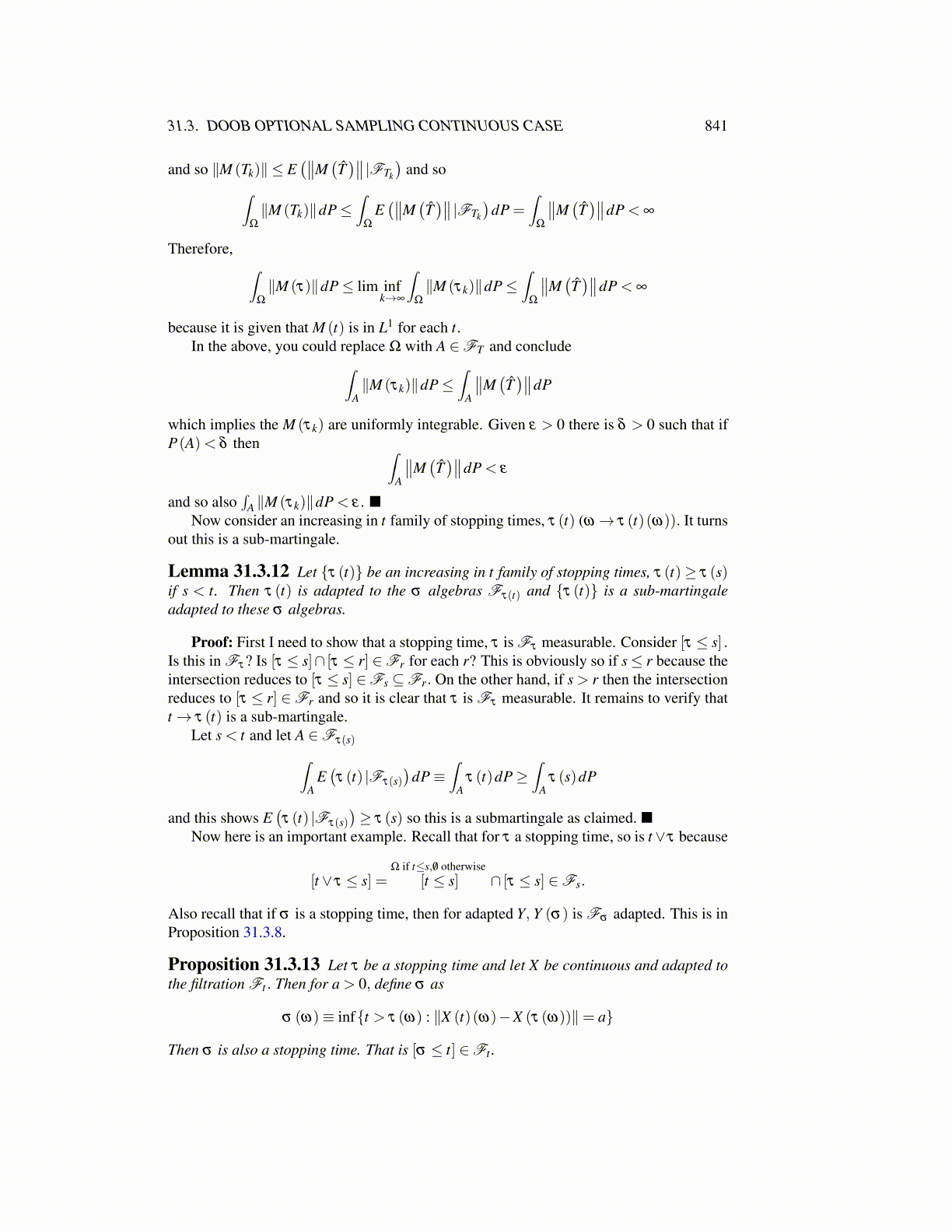
31.3. DOOB OPTIONAL SAMPLING CONTINUOUS CASE 841
and so ∥M (Tk)∥ ≤ E(∥∥M
(T̂)∥∥ |FTk
)and so∫
Ω
∥M (Tk)∥dP≤∫
Ω
E(∥∥M
(T̂)∥∥ |FTk
)dP =
∫Ω
∥∥M(T̂)∥∥dP < ∞
Therefore, ∫Ω
∥M (τ)∥dP≤ lim infk→∞
∫Ω
∥M (τk)∥dP≤∫
Ω
∥∥M(T̂)∥∥dP < ∞
because it is given that M (t) is in L1 for each t.In the above, you could replace Ω with A ∈FT and conclude∫
A∥M (τk)∥dP≤
∫A
∥∥M(T̂)∥∥dP
which implies the M (τk) are uniformly integrable. Given ε > 0 there is δ > 0 such that ifP(A)< δ then ∫
A
∥∥M(T̂)∥∥dP < ε
and so also∫
A ∥M (τk)∥dP < ε . ■Now consider an increasing in t family of stopping times, τ (t) (ω→ τ (t)(ω)). It turns
out this is a sub-martingale.
Lemma 31.3.12 Let {τ (t)} be an increasing in t family of stopping times, τ (t)≥ τ (s)if s < t. Then τ (t) is adapted to the σ algebras Fτ(t) and {τ (t)} is a sub-martingaleadapted to these σ algebras.
Proof: First I need to show that a stopping time, τ is Fτ measurable. Consider [τ ≤ s] .Is this in Fτ ? Is [τ ≤ s]∩ [τ ≤ r] ∈Fr for each r? This is obviously so if s≤ r because theintersection reduces to [τ ≤ s] ∈Fs ⊆Fr. On the other hand, if s > r then the intersectionreduces to [τ ≤ r] ∈Fr and so it is clear that τ is Fτ measurable. It remains to verify thatt→ τ (t) is a sub-martingale.
Let s < t and let A ∈Fτ(s)∫A
E(τ (t) |Fτ(s)
)dP≡
∫A
τ (t)dP≥∫
Aτ (s)dP
and this shows E(τ (t) |Fτ(s)
)≥ τ (s) so this is a submartingale as claimed. ■
Now here is an important example. Recall that for τ a stopping time, so is t∨τ because
[t ∨ τ ≤ s] =Ω if t≤s, /0 otherwise
[t ≤ s] ∩ [τ ≤ s] ∈Fs.
Also recall that if σ is a stopping time, then for adapted Y, Y (σ) is Fσ adapted. This is inProposition 31.3.8.
Proposition 31.3.13 Let τ be a stopping time and let X be continuous and adapted tothe filtration Ft . Then for a > 0, define σ as
σ (ω)≡ inf{t > τ (ω) : ∥X (t)(ω)−X (τ (ω))∥= a}
Then σ is also a stopping time. That is [σ ≤ t] ∈Ft .